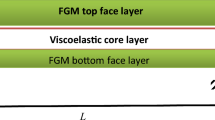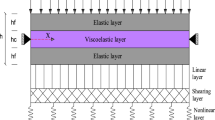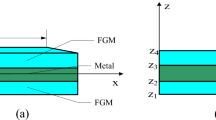Abstract
The present work explains about the vibration response of a viscoelastic sandwich beam with functionally graded material constraining layers. These layers are formed by varying the ceramic (Al2O3) and stainless steel (SUS304) composition along the thinness direction. The basic kinematics is considered from Timoshenko beam theory due to inertia effect. The sandwich beam is formulated. Three-layered sandwich beam is modelled using the finite element method. The top and bottom layers are FGM layers and the middle layer as a viscoelastic core. The linear displacement field is assumed to model the FGM layers and also the core layer displacement field as non-linear. Hamilton’s principle is used to derive the governing equation of motion of the viscoelastic sandwich beam. The vibration analysis has been carried out by using the derived governing equation of motion with cantilever and fixed–fixed boundary conditions. The obtained results are compared with the available literature results. The natural frequencies are calculated with different boundary conditions by varying the core thickness. The influence of core thickness and FGM constraining layer index value on natural frequencies are observed.
Access provided by Autonomous University of Puebla. Download conference paper PDF
Similar content being viewed by others
Keywords
1 Introduction
Vibration characteristics of sandwich structures are vital precise to study the dynamics analysis of structural members. The sandwich beam is one of the important structural members which is made up of two face sheets joined by viscoelastic core member as a middle layer. To reduce vibration, damping mechanism of a viscoelastic core is introduced for a sandwich beam. These sandwich structures have many applications such as railways, bridges, satellites, aeroplane wings and robotic arms etc.
Sandwich beam vibration analysis with exact solutions has been studied by Rao [1], and the various boundary conditions are used to calculate the frequency result, loss factors and the shear modulus assumed as a complex in the core model. Ganapathi et al. [2] studied the dynamic analysis of laminated composite and sandwich beam with loss factors. Arikoglu and Ozkol [3] examined the effect of viscoelastic core thickness on natural frequencies of three-layered sandwich beam model. A meshless method using penalty approach was studied by ChehelAmirani et al. [4] for vibration analysis of FG core sandwich beam with various boundary conditions. Abdoun et al. [5] studied the harmonic response of sandwich viscoelastic beam using an asymptotic numerical method.
Bilasse et al. [6] proposed a numerical solution using finite element approach for linear and non-linear vibration analysis of viscoelastic sandwich beam. Multi-layered sandwich beam modelled using finite element formulation for free vibration analysis has been presented by Mohanty [7]. Long et al. [8] where the finite element formulation is explained for sandwich structure and compared the obtained numerical simulation results of ANSYS with the reference results. Kpeky et al. [9] examined the solid-shell finite element formulation for sandwich structures modal analysis. Long [10] studied the active constraining layer of FG beam using finite element approach.
In the literature, there is no survey on bounds and soundness assortment of the sandwich structures damping responses. The numerical assessment related to this work is to improve a vibrant representation for vibration characteristics of damped sandwich beams. The main aim of the present work is to develop a finite element approach of a three-layered sandwich beam with cantilever and fixed–fixed boundary conditions and to investigate its vibration responses. The bottom and top face sheets are assumed to be FGM sheets, while the core is assumed as a viscoelastic layer. The FGM face sheets are made up of two materials, i.e. stainless steel and alumina, the viscoelastic core is assumed as polyurethane foam. The frequency response curves are obtained for various core loss factors, boundary conditions and different thickness ratios.
2 Mathematical Formulation
Sandwich beam with viscoelastic core as a middle is illustrated in Fig. 1. Timoshenko beam theory is adopted to model the bottom and top face FGM constraining layers.
The FGM constraining layer field variables are expressed as
The displacement vector of an element can be represented as:
The axial displacement of the viscoelastic core layer is denoted with a cubic function and the displacement of transverse direction is incorporated by the quadratic function.
Shape functions are represented as
2.1 The Material Properties of FGM Face Sheet
The material properties of FGM face sheets are varying in the thickness direction, the effective material properties such as \( (E_{\text{FG}} ) \) Young’s modulus, \( (\rho_{\text{FG}} ) \) mass density and \( (\vartheta_{\text{FG}} ) \) Poisson’s ratio is obtained as.
The relationship between the \( (V_{M} ) \) metal and \( (V_{C} ) \) ceramic volume fractions is represented using simple rule of mixture obtained as
The volume fraction of ceramic varies by using the simple power-law function is obtained as
In which, k is an index of the power law and h is the thickness of face sheet. The variation of index value k varies the ceramic volume fraction content. It causes to change the material properties of the FGM constraining layer.
2.2 FGM Face Sheet
The constraining elemental FGM beam layer kinetic energy is expressed as:
The kinetic energy of constraining layer of FGM beam element is expressed as
where \( \left[ {M_{\text{FG}} } \right]^{\left( e \right)} \) is mass matrix of FGM face sheet of beam element.
The stiffness matrix of FGM face sheet is expressed from the potential energy
where \( \left[ {K_{\text{FG}} } \right]^{\left( e \right)} \) is element stiffness matrix of FGM face sheet.
2.3 Viscoelastic Core
Viscoelastic core element kinetic energy can be represented as
where \( \left[ {M_{C} } \right]^{\left( e \right)} \) is element viscoelastic core mass matrix.
The elemental strain energy of viscoelastic core is expressed as
where \( \left[ {K_{C} } \right]^{\left( e \right)} \) is viscoelastic core element stiffness matrix.
2.4 Governing Equation of Motion
Hamilton’s principle is used to derive the governing equation of motion of viscoelastic sandwich beam element.
The equation of motion of sandwich beam element is represented as
Sandwich beam element’s potential energy is equal to the sum of the potential energy of the constraining layers and viscoelastic layer. Similarly, the kinetic energy of sandwich beam element is the sum of a viscoelastic element and FGM face sheets.
The equation of motion of sandwich beam by assembling of mass and elastic stiffness matrix is obtained as
3 Results and Discussion
Vibration response of sandwich beam with viscoelastic core can be studied using finite element method. The viscoelastic behaviour of a core material is assumed in a simple way by considering Young’s modulus E = Ev (1 + iηv), where Ev and ηv are constant. The derived equation of motion is used to determine the natural frequencies and loss factors for various modes. The first six modes of natural frequencies of a viscoelastic sandwich beam with a clamped-free boundary condition for various core loss factors are presented in Table 1. These results are reasonably good of those provided by the literature of references Bilasse et al. [6] and Abdoun et al. [5] observed in Table 1.
Material properties which are used for this analysis are presented below.
-
Young’s modulus of elastic face sheet = 6.9 × 1010 Nm−2
-
Poisson ratio of elastic face sheet = 0.3
-
Density of elastic face sheet = 2766 kg m−3
-
Viscoelastic material properties:
-
Young’s modulus E = 1.794 × 106 Nm−2
-
Poisson ratio \( \upsilon_{c} = 0.3 \)
-
Density \( \rho_{c} = 968.1\;{\text{kg}}\;{\text{m}}^{ - 3} \)
The material properties of the ceramic and metal are as follows:
Figure 2a, b represents the frequency variation with respect to the loss factor of the viscoelastic sandwich beam with FGM face sheets of a cantilever and both sides fixed boundary conditions, respectively. It is noticed that the first three mode frequencies are reduced with an increase of loss factor. The increase of loss factor reduces its overall stiffness matrix of the sandwich beam, which may cause marginally reduces its frequencies.
The variation of loss factor with respect to the core loss factor is shown in Fig. 3a, b, correspondingly. The loss factor is decreased with an increase of core loss factor. This is because of increase of core loss factor. The first mode loss factor decrease of variation can be observed in these figures. Similarly, the other two modes are also varied to a certain extent.
Figure 4a, b illustrated the frequency versus thickness ratio (FGM face sheet to the core) for cantilever and both sides fixed boundary conditions. It indicates that the increase of thickness ratio reduces the first three mode frequencies. There is no effect of the bending moment and displacement for fixed–fixed condition on the frequencies. Hence, higher frequency values.
The variation of loss factor against thickness ratio of a sandwich beam for cantilever and both sides fixed boundary conditions is shown in Fig. 5a, b. Here, the increase of thickness ratio may decrease the first mode frequency; similarly, the increase of thickness ratio increases the second and third mode frequencies of FGM constraining layer sandwich beam. The reasons might be the effect of eigenvalues.
4 Conclusions
Vibration responses and loss factors are obtained for a viscoelastic sandwich beam with various boundary conditions by using the present developed finite element modal. Timoshenko beam theory is assumed for basic kinematics. In the presently developed modal of the finite element method with three layer sandwich beam. The governing equation of motion of viscoelastic sandwich beam is derived by Hamilton’s principle. The influence of loss factor on the natural frequencies is observed. The natural frequencies are reduced with an increase of loss factor. The effect of loss factor on the thickness ratio also calculated. An increase of core thickness will decrease the first mode and correspondingly, increase the second and third mode frequency of cantilever sandwich beams.
Abbreviations
- h :
-
Thickness of FGM face sheet
- u :
-
Displacement in x direction
- w :
-
Displacement in transverse direction
- N :
-
Shape function
- \( \{ q\} \) :
-
Final displacement vector
- \( \left\{ {q^{\left( e \right)} } \right\} \) :
-
Element displacement vector
- \( [K] \) :
-
Final stiffness matrix
- \( \left[ {K^{\left( e \right)} } \right] \) :
-
Element stiffness matrix
- \( \left[ {K_{C} } \right]^{\left( e \right)} \) :
-
Element stiffness matrix of a viscoelastic core
- \( \left[ {K_{\text{FG}} } \right]^{\left( e \right)} \) :
-
Element stiffness matrix of a constraining layer of FGM
- \( [M] \) :
-
Final mass matrix
- \( \left[ {M^{\left( e \right)} } \right] \) :
-
Element mass matrix
- \( \left[ {M_{C} } \right]^{\left( e \right)} \) :
-
Element mass matrix of a viscoelastic core
- \( \left[ {M_{\text{FG}} } \right]^{\left( e \right)} \) :
-
Element mass matrix of a constraining layer of FGM
- \( \rho_{FG} \) :
-
Density of FG
- \( \rho_{C} \) :
-
Density of viscoelastic core
- \( V_{C} \) :
-
Volume fraction of ceramic
- \( V_{M} \) :
-
Volume fraction of metal
- \( \eta \) :
-
Loss factor
- \( \eta_{v} \) :
-
Core loss factor
References
Rao DK (1975) Frequency and loss factors of sandwich beams under various boundary conditions. J Mech Eng Sci 20(5):271–282
Ganapathia M, Patel BP, Boisse P, Polit O (1999) Flexural loss factors of sandwich and laminated composite beams using linear and nonlinear dynamic analysis. Compos: Part B 30:245–256
Arikoglu A, Ozkol I (2010) Vibration analysis of composite sandwich beams with viscoelastic core by using differential transform method. Compos Struct 92:3031–3039
ChehelAmirani M, Khalili SMR, Nemati N (2009) Free vibration analysis of sandwich beam with FG core using the element free Galerkin method. Compos Struct 90:373–379
Abdoun F, Azrar L, Daya EM, Potier-Ferry M (2009) Forced harmonic response of viscoelastic structures by an asymptotic numerical method. Comput Struct 87:91–100
Bilasse M, Daya EM, Azrar L (2010) Linear and non-linear vibrations analysis of viscoelastic sandwich beams. J Sound Vib 329:4950–4969
Mohanty SC (2011) Finite element modeling of a multilayered sandwich beam with viscoelastic core for vibration analysis, vol 10. In: International Conference on modeling, simulation and control, IPCSIT, pp 103–108
Long R, Barry O, Oguamanam DCD (2012) Finite element free vibration analysis of soft-core sandwich beams. AIAA J 50(1):35–38
Kpeky F, Boudaoud H, Abed-Meraim F, Daya EM (2015) Modeling of viscoelastic sandwich beams using solid–shell finite elements. Compos Struct 133:105–116
Long R (2010) A finite element formulation of active constrained-layer functionally graded beam. Ryerson University, Toronto
Author information
Authors and Affiliations
Corresponding author
Editor information
Editors and Affiliations
Rights and permissions
Copyright information
© 2020 Springer Nature Singapore Pte Ltd.
About this paper
Cite this paper
Ramu, I., Raghuraman, M., Seshu, K.V.G.R. (2020). Vibration Response of Sandwich Beam with Viscoelastic Core and FGM Face Sheets Using Finite Element Method. In: Vijayaraghavan, L., Reddy, K., Jameel Basha, S. (eds) Emerging Trends in Mechanical Engineering. Lecture Notes in Mechanical Engineering. Springer, Singapore. https://doi.org/10.1007/978-981-32-9931-3_37
Download citation
DOI: https://doi.org/10.1007/978-981-32-9931-3_37
Published:
Publisher Name: Springer, Singapore
Print ISBN: 978-981-32-9930-6
Online ISBN: 978-981-32-9931-3
eBook Packages: EngineeringEngineering (R0)









